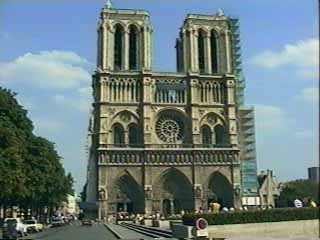 |
Notre Dame is the work
of Maurice de Sully, bishop of Paris from 1160 to 1196 who, inspired by
Abbot Suger, builder of St. Denis, desired to present his city with a cathedral
which would do it honor. The general plan, containing a transept
which divides the interior into a nave
and a chevet of nearly equal proportion,
with a tripartite division of nave and chevet which is reflected in the
articulation of the facade, became the prototype for all the great gothic
structures which came after it. Its great rose
window, perfectly planned and executed, was the largest of its kind, and
the flying buttresses of the nave
innovative in their design.
As the majority of construction was completed during its founding bishop's lifetime, it shows a remarkable stylistic unity. The dedication of the high altar took place only twenty years after work was begun, and during the reign of Louis IX, in 1239, the cathedral was able to house the king's prize purchase, the Crown of Thorns, while the Sainte Chapelle was under construction. The principal modifications of the 13th and 14th centuries concern the windows of the nave, which were enlarged, and the numerous chapels added between the buttresses. |